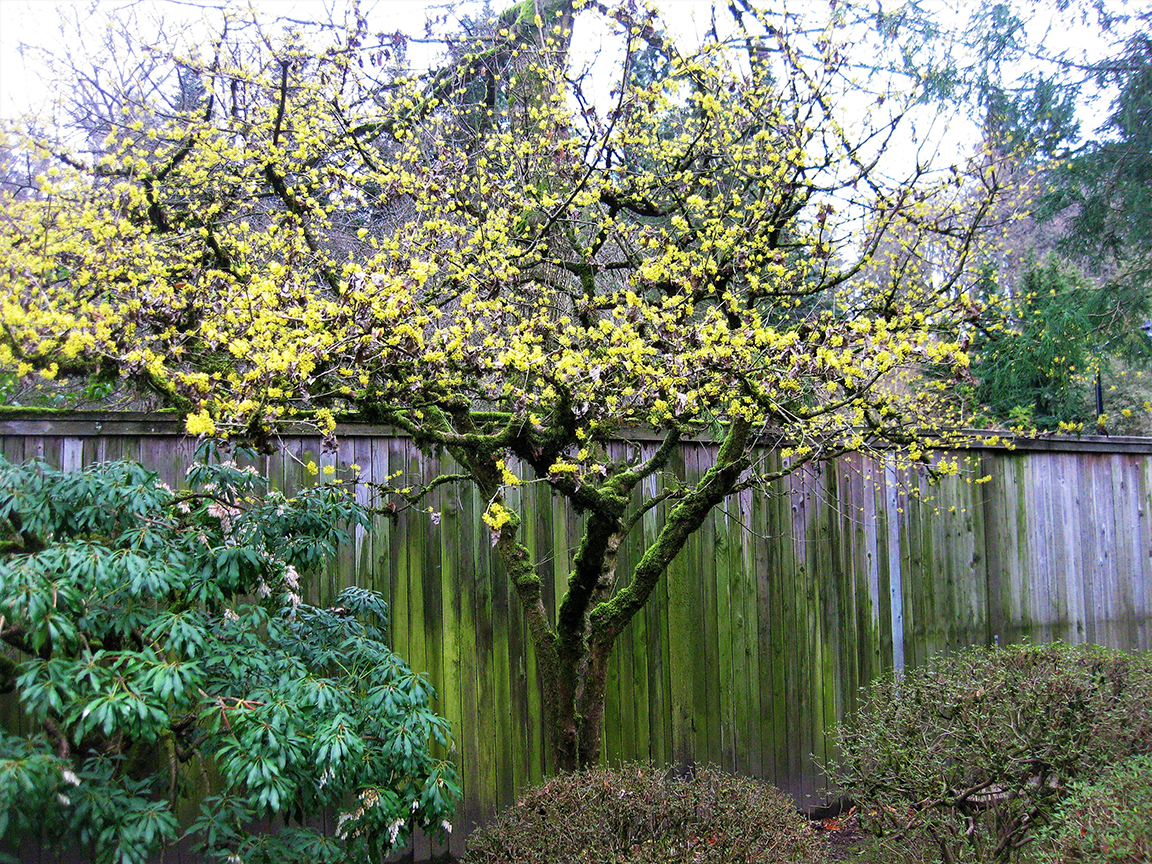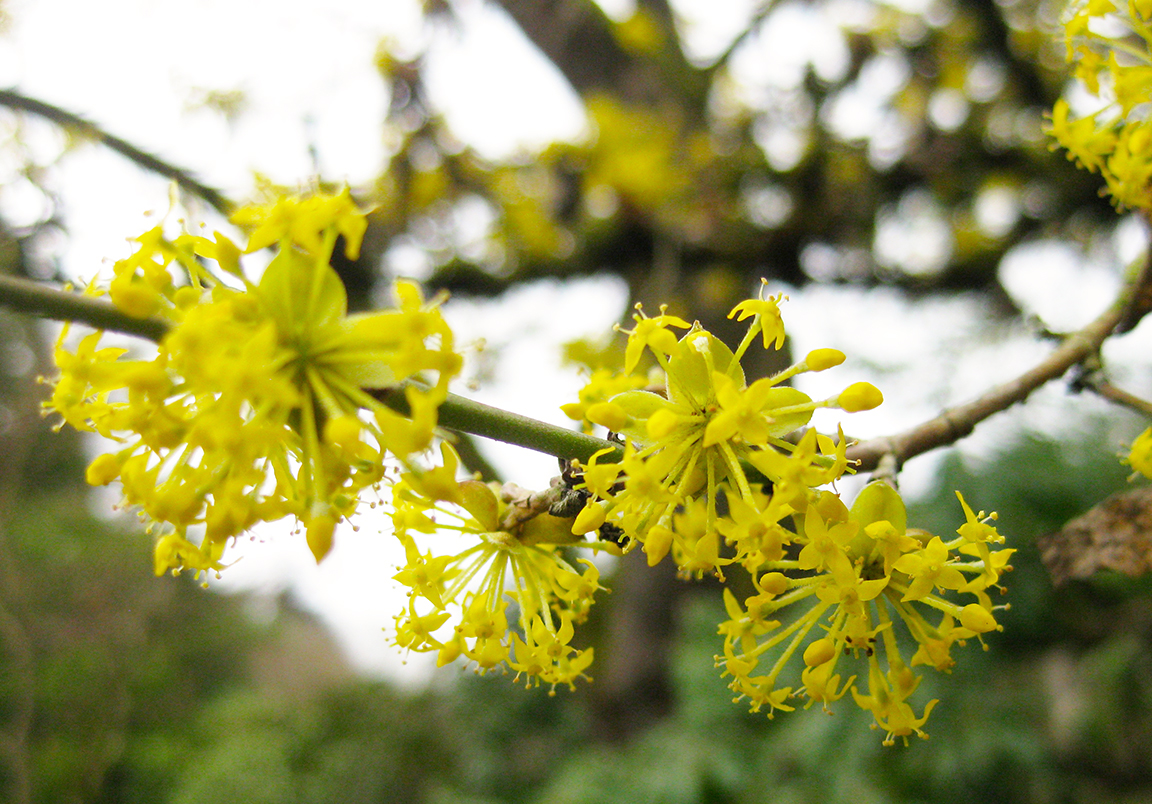The Bright Yellow Flowers of Cornus mas are an Early Promise of Spring
By Corinne Kennedy
Cornelian cherry tree in Area L, along the garden’s eastern fence. (photo: Aleks Monk, 3/5/13)
Cornus mas is a small deciduous tree that brightens the winter garden with its cheerful February blooms. Despite its common name, cornelian cherry is a species of dogwood, not a true cherry -- and is sometimes known as cornelian cherry dogwood. Like forsythia and many other early-blooming trees and shrubs, it has bright yellow flowers. Little known, but attractive and adaptable, it deserves to be more widely planted.
Our Seattle Japanese Garden has two specimens, both in Area L, near the garden’s northern end on the east side of the pond. They bloom in February and often into March, the month that the garden usually opens after its 3-month winter closure. This year, a major renovation project will delay our garden’s opening until early April, so interested visitors will need to go elsewhere to view the flowers of this lovely tree. Fortunately, it’s also planted throughout the Washington Park Arboretum and at the Center for Urban Horticulture, in a grove along NE 41st Street.
Cornus mas is native to Europe and southwestern Asia, but not to Japan. The genus name, Cornus, refers to dogwood trees & shrubs, and the species name, mas, means male – a usage that dates to Roman times. Plants are monoecious – that is, male & female flowers appear on the same plant. However, young plants bear only male flowers and are fruitless; hence they’re easily mistaken for males. The common name, cornelian cherry, refers to the cherry-like fruits and their color, which resembles that of the gemstone carnelian.
Cultivated for many centuries for the medicinal properties of its seeds, fruits, leaves and stems, cornelian cherry was used historically to treat infectious diseases, and to protect against heart, kidney, and liver problems. In recent times, scientific studies have shown that it has anti-inflammatory and antioxidant properties, and has protective effects against parasites, microbes and cancers. In addition, it has long been valued for its ornamental qualities and edible fruit.
Mid to late winter flowers of the cornelian cherry dogwood. (photo: Aleks Monk, 3/5/13)
Cornus mas is hardy to USDA Zones 4 or 5 to 8 (minimum winter temperature: -30 or -20 degrees F.), and grows to a mature size of about 15 feet tall by 15-20 feet wide, with an upright-rounded habit of growth. Multi-trunked, or pruned to a single trunk with low branching, it has a shrub-like appearance, and is sometimes considered a large shrub rather than a small tree. Maturing plants cast dense shade, causing plants growing beneath them to die out. Young stems are greenish, maturing to a purplish-brown with lighter undersides. The scaly bark is dark gray or reddish-brown in color, and the wood valued for its flexibility, hardness and durability.
In mid-winter, before the leaves emerge, round buds open to small, bright yellow flowers in tight clusters. Leaves are a glossy dark green, about 3 inches long, and held opposite each other on their stems. They are widest in the middle, with wavy margins and pointed tips. In fall, they develop attractive purple-red tones, especially when plants are grown in full sun.
Edible drupes (fleshy fruits, with a single hard stone, like cherries) mature in late summer, but are mostly hidden by the foliage. Bright red, olive-shaped and about ½ inch long, they have relatively large stones. Although very tart, they’re attractive to birds and squirrels. Traditionally used to make ciders, liqueurs, sweets and even pickles, they are now most often made into jams and jellies.
Cornus mas grows best in moist, well-drained soils in full sun or light to open shade. An easy-to-grow, adaptable plant, it tolerates a wide variety of soils – sand & clay, acid & alkaline. Long-lived, heat and drought tolerant, it is also pest and disease resistant. However, there is one drawback: dropped fruits will stain any pavement beneath them!
With its small size, adaptability, wildlife value and ease of cultivation, cornelian cherry is an excellent choice both for naturalizing and for planting in small urban gardens. In the Pacific Northwest, its very early flowers are a welcome antidote to our long gray winters. Instead of planting forsythia, an early-blooming cliché, consider planting Cornus mas. It’s much less common, blooms earlier, is attractive in several seasons, and is an appropriate size for almost any garden. When the Seattle Japanese Garden re-opens each year -- typically in early March -- it brings glowing yellow color and the promise of spring to the garden’s earliest visitors.
Corinne Kennedy is a Garden Guide, a frequent contributor to the Seattle Japanese Garden blog, and retired garden designer.


